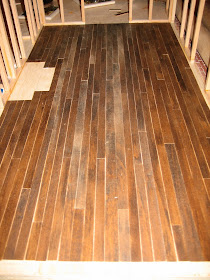
The time period I picked for Myrtlewood is the mid-1880s. For that reason, and also because I don't really care for the look of dollhouse carpeting, Myrtlewood will have wood flooring throughout. This is a big project, as I am cutting and placing each plank individually. Here you can see how I made the parlor floor.
Click here to read the rest of this entry...
First, I pre-conditioned and stained several pieces of 1/32" basswood a deep walnut color. I chose to stain the wood first, rather than laying it all and then staining it, because I like to take the wood grain into account when placing each plank, and I can see the grain much more clearly when it's been stained.

I cut planks 3/8 inches wide by 12 inches long and began laying them onto the plywood base, staggering the end joints, as you can see below.

As I glued them down to the floor, I weighted them down for a few minutes to keep the planks from curling up on the ends. Some people use contact cement instead of glue to keep the thin wood from curling, but you can't really move the pieces once they've contacted the base, and I'm just not skilled enough to lay everything perfect the first time! I need to be able to adjust each plank slightly after I've laid it down on the base. So I just use regular wood glue and a very sophisticated weighting system:

Here's what the floor looked like once I'd laid all the planks:

After I was sure that all the glue had dried, I sanded the entire floor to smooth it out, wiped up all the sawdust with a damp cloth and then restained the entire floor. Once the stain dried, I gave the floor two coats of a polyurethane sealer, sanding lightly in between coats. Here is the finished floor:

One floor down, only eighteen more to go!






